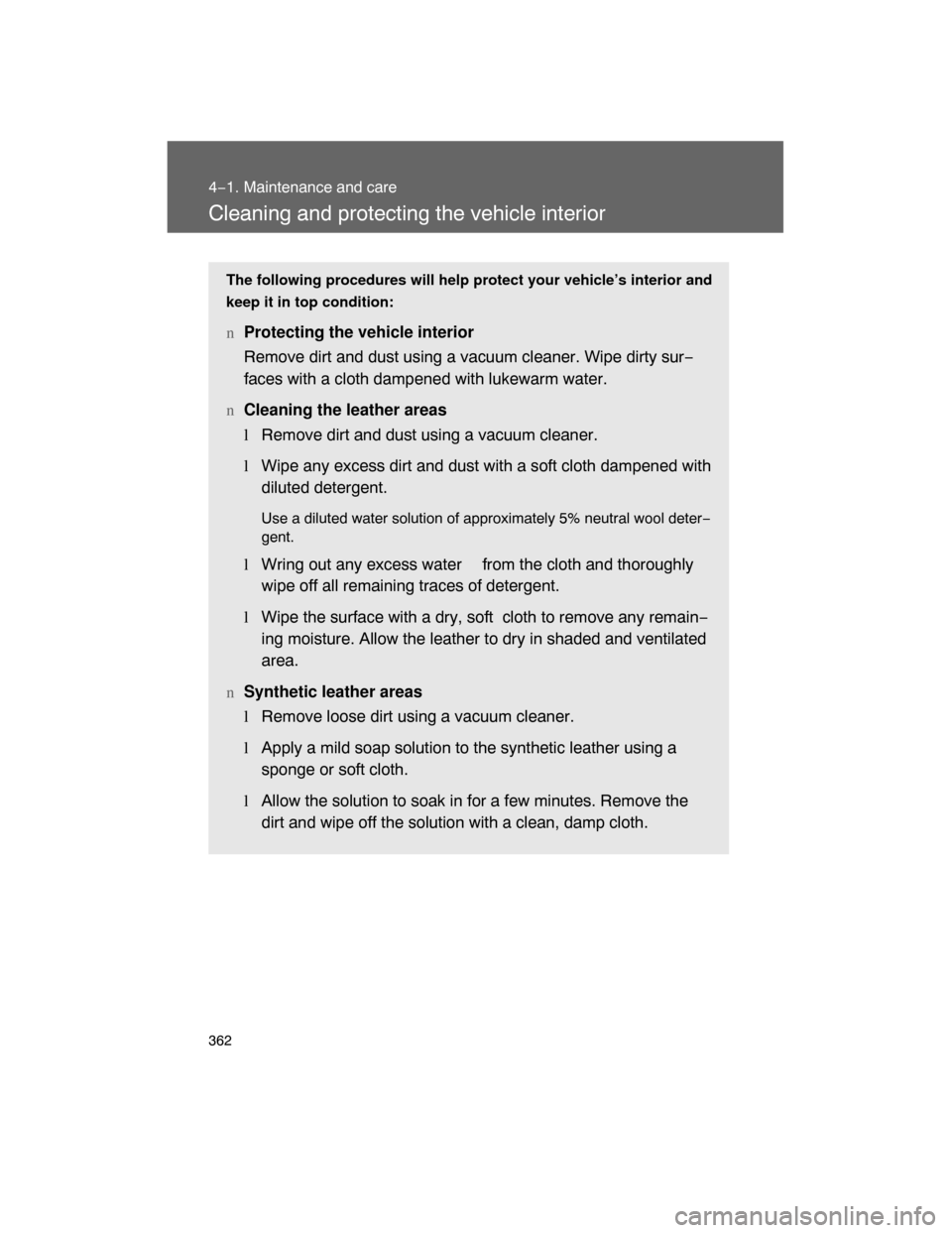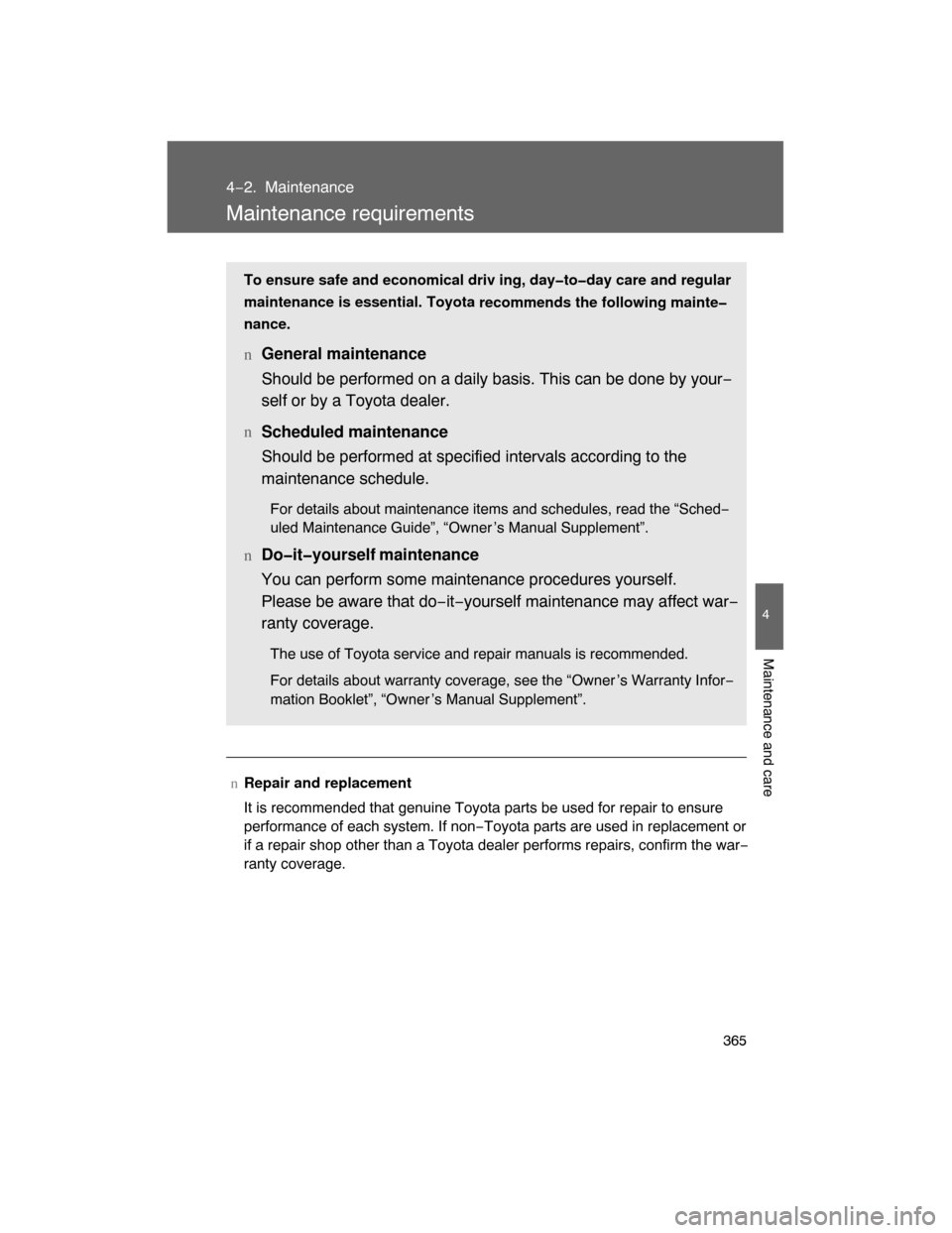Page 357 of 531

362
4−1. Maintenance and care
Cleaning and protecting the vehicle interior
The following procedures will help protect your vehicle’s interior and
keep it in top condition:
nProtecting the vehicle interior
Remove dirt and dust using a vacuum cleaner. Wipe dirty sur−
faces with a cloth dampened with lukewarm water.
n
Cleaning the leather areas
l
Remove dirt and dust using a vacuum cleaner.
lWipe any excess dirt and dust with a soft cloth dampened with
diluted detergent.
Use a diluted water solution of approximately 5% neutral wool deter−
gent.
lWring out any excess water from the cloth and thoroughly
wipe off all remaining traces of detergent.
l
Wipe the surface with a dry, soft cloth to remove any remain−
ing moisture. Allow the leather to dry in shaded and ventilated
area.
nSynthetic leather areas
lRemove loose dirt using a vacuum cleaner.
l
Apply a mild soap solution to the synthetic leather using a
sponge or soft cloth.
lAllow the solution to soak in for a few minutes. Remove the
dirt and wipe off the solution with a clean, damp cloth.
Page 358 of 531

363
4−1. Maintenance and care
4
Maintenance and care
nCleaning the inside of the rear window
Do not use glass cleaner to clean the rear window, as this may cause dam−
age to the rear window defogger heater wires. Use a cloth dampened with
lukewarm water to gently wipe the window clean. Wipe the window in
strokes running parallel to the heater wires or antenna.
nCaring for leather areas
Toyota recommends cleaning the interior of the vehicle at least twice a year
to maintain the quality of the vehicle’s interior.
nShampooing the carpets
There are several commercial foaming−type cleaners available. Use a
sponge or brush to apply the foam. Rub in overlapping circles. Do not apply
water. The excellent results are obtained by keeping the carpet as dry as
possible.
nSeat belts
Clean with mild soap and lukewarm water using a cloth or sponge. Also
check the belts periodically for excessive wear, fraying or cuts.
CAUTION
nWater in the vehicle
lBe careful not to splash or spill liquid on the floor.
lDo not get any of the SRS components or wiring in the vehicle interior wet.
( P. 104)
Electrical malfunction may cause the airbags to deploy or not function
properly, resulting in death or serious injury.
Page 359 of 531

364 4−1. Maintenance and care
NOTICE
nCleaning detergents
Do not use the following types of detergent, as they may discolor the vehicle
interior or cause streaks or damage to painted surfaces.
lNon−seat portions: Organic substances such as benzene or gasoline,
alkaline or acidic solutions, dye, or bleach.
lSeats: Acidic solutions, such as thinner, benzene, or alcohol.
nPreventing damage to leather surfaces
Observe the following precautions to avoid damage to and deterioration of
leather surfaces.
lRemove any dust or dirt on leather surfaces immediately.
lDo not expose the vehicle to direct sunlight for extended periods of time.
Park the vehicle in the shade, especially during summer.
lDo not place items made of vinyl, plastic, or that contain wax on the uphol−
stery, as they may stick to the leather surface if the vehicle interior heats
up significantly.
nWater on the floor
Do not wash the vehicle floor with water.
Vehicle systems such as the audio system may be damaged if water comes
into contact with electrical components under the floor of the vehicle, and
may also cause the body to rust.
n
Cleaning the inside of the rear window
Be careful not to scratch or damage the heater wires or antenna.
Page 360 of 531

365
4
Maintenance and care
4−2. Maintenance
Maintenance requirements
nRepair and replacement
It is recommended that genuine Toyota parts be used for repair to ensure
performance of each system. If non−Toyota parts are used in replacement or
if a repair shop other than a Toyota dealer performs repairs, confirm the war−
ranty coverage. To ensure safe and economical driv ing, day�to�day care and regular
maintenance is essential. Toyota
recommends the following mainte�
nance.
nGeneral maintenance
Should be performed on a daily basis. This can be done by your−
self or by a Toyota dealer.
n
Scheduled maintenance
Should be performed at specified intervals according to the
maintenance schedule.
For details about maintenance items and schedules, read the “Sched−
uled Maintenance Guide”, “Owner ’s Manual Supplement”.
nDo�it�yourself maintenance
You can perform some maintenance procedures yourself.
Please be aware that do−it−yourself maintenance may affect war−
ranty coverage.
The use of Toyota service and repair manuals is recommended.
For details about warranty coverage, see the “Owner ’s Warranty Infor−
mation Booklet”, “Owner ’s Manual Supplement”.
Page 361 of 531

366 4−2. Maintenance
nAllow inspection and repairs to be performed by a Toyota dealer
lToyota technicians are well−trained specialists and are kept up to date
with the latest service information. They are well informed about the
operations of all systems on your vehicle.
l
Keep a copy of the repair order. It proves that the maintenance that has
been performed is under warranty coverage. If any problem should arise
while your vehicle is under warranty, your Toyota dealer will promptly
take care of it.
CAUTION
nWarning in handling of battery, oils, fuels, and fluids
lEngine exhaust, some of its constituents, and a wide variety of automobile
components contain or emit chemicals known to the State of California to
cause cancer and birth defects and other reproductive harm. Work in a
well ventilated area.
lOils, fuels and fluids contained in vehicles as well as waste produced by
component wear contain or emit chemicals known to the State of Califor−
nia to cause cancer and birth defects or other reproductive harm. Avoid
exposure and wash any affected area immediately.
lBattery posts, terminals and related accessories contain lead and lead
compounds which are known to cause brain damage. Wash your hands
after handling. (
P. 387)
Page 362 of 531
367
4−2. Maintenance
4
Maintenance and care
General maintenance
Engine compartment
Items Check points
Battery�Maintenance−free (
P. 387)
Brake fluid�At the correct level? (
P. 384)
Engine coolant�At the correct level? (
P. 382)
Engine oil�At the correct level? (
P. 377)
Exhaust system�No fumes or strange sounds?
Power steering fluid�At the correct level? (
P. 386)
Radiator/condenser/hoses�Not blocked with foreign matter?
( P. 383)
Washer fluid�At the correct level? (
P. 338)
Listed below are the general maintenance items that should be per�
formed at the intervals specified
in the “Owner ’s Warranty Informa�
tion Booklet”, “Owner ’s Manual Supplement”. It is recommended
that any problem you notice should be brought to the attention of
your Toyota dealer or qualified service shop for advice.
Page 363 of 531
368 4−2. Maintenance
Vehicle interior
Items Check points
Accelerator pedal�Moves smoothly (without uneven
pedal effort or catching)?
Automatic transmission “Park”
mechanism�Can the vehicle be hold securely
on an incline with the shift lever in
“P”?
Brake pedal�Moves smoothly?
�Does it have appropriate clear−
ance and correct amount of free
play?
Brakes�Pulls to one side when applied?
�Loss of brake effectiveness?
�Spongy feeling brake pedal?
�Pedal almost touches floor?
Head restraints�Move smoothly and lock
securely?
Indicators/buzzers�Function properly?
Lights�Do all the lights come on?
�Headlights aimed correctly?
Parking brake�Moves smoothly?
�Can hold the vehicle securely on
an incline?
Seat belts�Does the seat belt system oper−
ate smoothly?
�Are the belts undamaged?
Seats�Do the seat controls operate
properly?
Steering wheel
�Moves smoothly?
�Has correct free play?
�No strange noises?
Page 364 of 531
369
4−2. Maintenance
4
Maintenance and care
Vehicle exterior
Items Check points
Doors�Operate smoothly?
Engine hood�The lock system works properly?
Fluid leaks�Is there any leakage after park−
ing?
Ti re�Inflation pressure is correct?
�Tire surfaces not worn or dam−
aged?
�Tires rotated according to the
maintenance schedule?
�Wheel nuts are not loose?
CAUTION
nIf the engine is running
Turn off the engine and ensure that there is adequate ventilation before per−
forming maintenance checks.